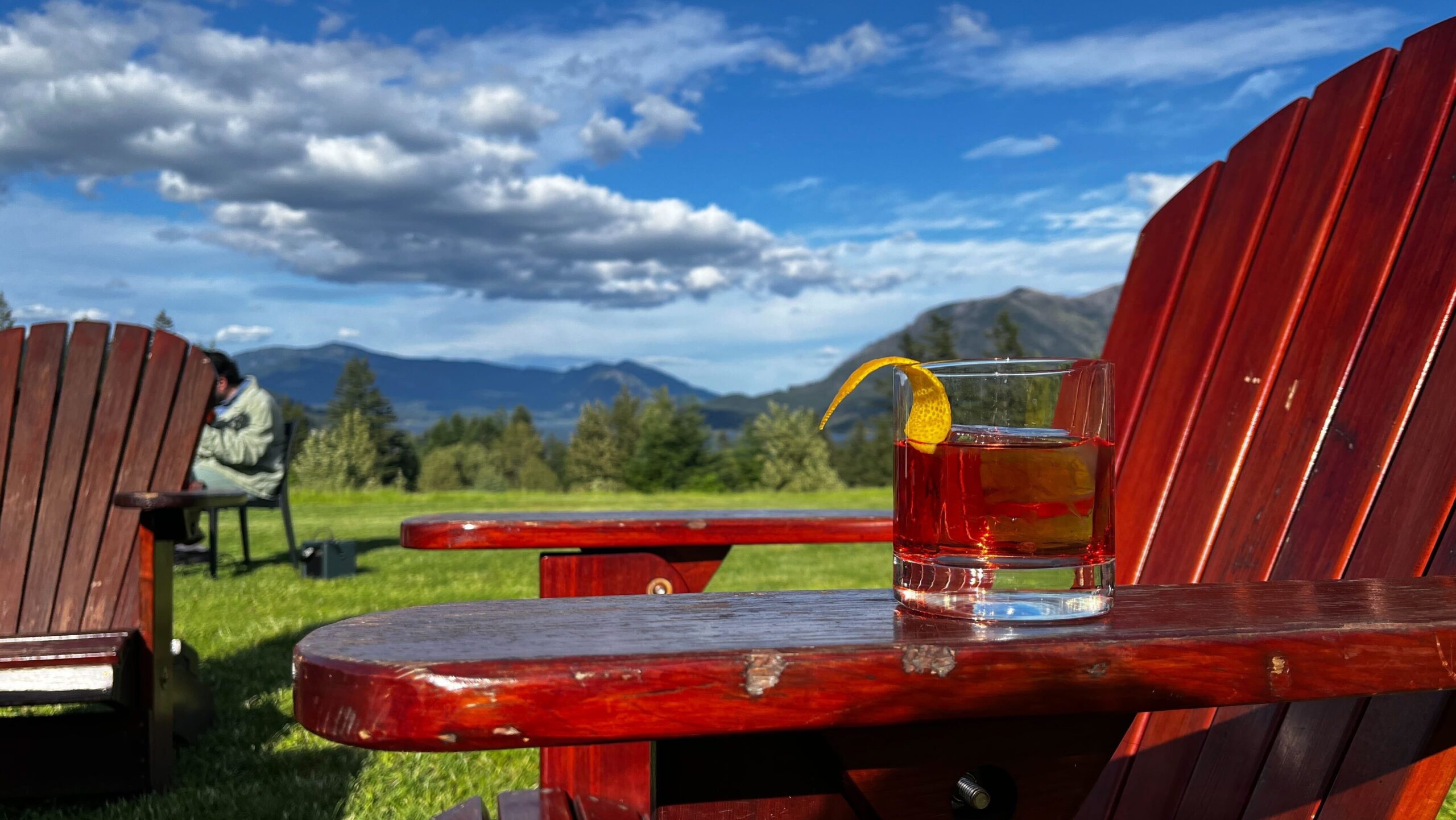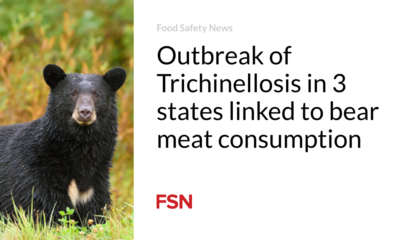Technology
Inside the first non-alcoholic distillery in the United States

I’m in the woods near Wahclella Falls, and I’m looking at an innocuous-looking plant that could be mistaken for parsley, except it’s water hemlock—found all over the United States and highly poisonous to humans. It’s what killed Socrates. Its nontoxic fraternal twin is Angelica archangelica—angelica or wild celery, one of the 150 mysterious herbs Carthusian monks use to make Chartreuse. These two plants function differently despite being part of the same family (Apiaceae). Foraging is a game of distinguishing the leaves that kill from those that won’t, and I’m thankful I’m in the company of folks who know the difference. I’m one of 12 journalists on a foraging hike led by Wilderton, a botanical spirits company based out of Hood River, Oregon, and I want to make it home to share what I learned.
There are plenty of NA breweries in the country, but this is the first non-alcoholic distillery and tasting room in the United States. The company uses distillation—the act of separating and concentrating components in a liquid mixture—like a traditional spirits company. However, Wilderton isn’t trying to recreate popular spirits verbatim, nor does the company aim to create a proxy that does its best to resemble the “real thing.” Wilderton makes something completely different with herbs, flowers, and botanicals, taking notes from perfuming, tea, and chemistry to make a scrumptious zero-proof spirit.
Amanda Reed



Amanda Reed
During my stay, we live in a state of in-between. Make that in between states. Our lodging, Skamania Lodge, is on the border of Oregon and Washington, right by the Pacific Coast Trail. We constantly drive over the Bridge of the Gods above the azure waters on the way to the dense Douglas Firs surrounding us in Stevenson and back again. We alternate between stainless steel drums on concrete floors and lush Pacific Northwest trails, blond wood paneling and straight-up woods. We learn about herbs and botanicals that taste awful in one application but come alive in another. And, of course, we distinguish the leaves that could kill you from those that won’t.
Wilderton also occupies a liminal state. Sure, its Bittersweet Aperitif gives Campari and Aperol a run for their money, but it acts more as an ode—albeit an excellent one—than a dupe. A combination of grapefruit, gentian, and orange blossom gives it that signature aperitif bitterness and brightness, but you’ll also find sandalwood, rosemary, and our good friend angelica. Lustre and Earthen are the company’s version of white and dark spirits, respectively, but not a particular kind of spirit in those two families, say gin or whiskey.
In fact, Brad Whiting and Seth O’Malley, Wilderton founders, don’t use the word “mocktail” to describe what you can do with Wilderton. There’s nothing mock about these spirits or what you can make from them. They prefer the term “zero-proof.”
“It’s not non-alc for the sake of being non-alc,” Whiting says. “It’s its own thing that brings amazing flavors.”
Making Wilderton
The hamster that runs around in Seth O’Malley’s brain isn’t sprinting on a wheel. It’s doing reformer pilates or paddle board yoga. That is to say, his mind doesn’t move in one direction. It twists with intention. One moment, he’s explaining the retro nasal olfaction system, then he’s giving us the linguistics lowdown on semantic bleaching, and next, without modifying his flow, he’s cracking a self-deprecating joke about the numerous everyday applications of a humanities major—all too relatable for the journalists in the room who aren’t regularly referring to T.S. Eliot or figuring out themes and symbols in “The Sound and the Fury” by William Faulkner. And yet, when I’m sticking my head in a shiny 17-foot tall still and breathing in peppercorn and cardamom so deeply I can visualize the vines and stems they came from, I’m grateful that I, too, spent years learning how to describe their redolence.
O’Malley’s journey to creating Wilderton is just as winding as his synapses and exacting as his sinuses. His origin story starts at 15 when he got really into tea—an extension of a lifelong love of plants. A new tea shop had opened in his hometown of Bend, Oregon, and he asked for a menu to take home to annotate. Stopping by eventually led to working there, befriending the owner, teaching tea classes, making recommendations, reading on the subject, and trying out different ways of brewing. He eventually moved up to Portland for college and worked at the shop in the evenings.
“That was sort of my first love with all of this, and I remain to this day a very, very passionate tea consumer,” he says.
During the beginning of O’Malley’s post-grad career, the owner of the tea company invited him back to work on a kombucha venture. During the tour of Wilderton’s small-but-mighty industrial-chic facility facing the Hood River Waterfront Park (which you can tour, free NA beverage included), O’Malley points out that this was his introduction to alcohol production. However, the magic figure was .5 percent: Any higher, and it legally has to be sold in a wine store or beer distributor. The government cracked down on the alcohol content of kombucha in 2010, and the aforementioned tea company owner invested in vacuum distillation machinery that would remove the alcohol content without killing the probiotics or fizziness that gives kombucha its zing.
“He invited me and my wonderful humanities degree to be in charge of taking the alcohol out of the kombucha,” O’Malley says.
That included figuring out what to do with the kombucha’s alcoholic effluent, which smelled like the fermented infusions that went through the machine. Serendipitously, his aromatic interests had unfurled beyond tea into spirits like juniper-forward gin, the Italian amaro tradition, unlocking Chartreuse’s secrets, absinthe, and aquavit.
“This was an opportunity to run a botanical spirits distillery where I had all the free alcohol in the world … I like to say that the canvas was partially painted, and I had to fill out the rest,” he says.
O’Malley, a self-described completist, wanted to find all the plants that could be used in a spirit and collect them, like a mad scientist or kid in their Pokémon era.
“The whole point for me of all of this … is formulating something that uses botanicals and using process and tools to convey those botanicals to people in some sort of finished form, like a spirit or a cup of tea,” he says.
Whiting, meanwhile, had a long career in traditional distilled spirits and was looking for the next challenge. Inspired by Seedlip and the UK’s lead in the non-alcoholic space—along with an existential crisis brought on by fatherhood and age—he decided NA spirits was the next move. Finding a distiller to match, however, was difficult.
“They all said, ‘Why are you coming to us, we make alcohol,” and I said, ‘No, you use distillation’ … All these people were just looking at it with an alcohol lens.”
Whiting was looking for the kind of distillation process that makes witch hazel and perfume, not the kind that makes vodka and other spirits. Alcohol is great at extracting things, but using vacuum distillation with alcohol concentrates the alcohol content. Whiting needed a distiller that could use vacuum distillation to concentrate aromas and flavors.
After making 20 calls, Whiting was expecting another “No” when he called O’Malley to float the idea. The 21st time was the charm.
O’Malley not only had the distillation knowledge Whiting was looking for, but he knew about water extraction thanks to his years of tea experience, which was important for making a botanical spirit that’s zero-proof from the jump.
“By the time Brad approached me, I was collecting all these botanicals, I was doing tests on them, figuring out what extracts well in water, what extracts in oil and alcohol. I’ve always been thinking, ‘How can I get more flavor in front of people?’” O’Malley says.




Amanda Reed
Beyond brewing tea, Wilderton’s research and development was inspired by another fragrant liquid: perfume. Unlike often secretive spirits producers, perfumers are better at collecting notes as they combine plant oils and synthetic compounds, applying the scientific method and publishing their findings for others to use.
Like perfumers, O’Malley starts with a pyramid and starts plugging in what notes he wants. The top notes are fleeting, the base notes linger, and the middle notes do a bit of both. In a channel separate from the pyramid, he’ll map the non-aromatic things he wants to invoke, like bitterness.
“And then from there, I’ll start just throwing things at the wall and try to, I always say, figure out the banks of the river,” he says.
Finding the river banks isn’t always easy, especially in the realm of non-alcoholic spirits. The formula for something like brandy is set in stone. Floral notes that emerge from wine are a result of grape type and terroir, but brought into focus through the lenses of well-established fermentation technique. Great wines and winemakers have their hallmarks, but there’s also a random element in every vintage. If O’Malley smells a violet note in something he’s testing, however, it’s deliberate and definable. Making a botanical spirit involves work from the ground up, literally and philosophically.
Ironically, an easy base for making an NA spirit more potent, more reactive, is to have it taste more “deadly” than it is. Alcohol is a poison, and we experience a physiological response to it. It’s also sweet—a dropper full of vodka in a glass of water brings out that sweetness, its pungency, its acridity, and adds some heat. Other NA spirits do this by adding capsicum to make it spicy. It’s something O’Malley thought about when making an NA spirit: What is the flavor of alcohol, anyway, and how can you echo its bracing sensation?
O’Malley is in the camp that the best tasting experiences include something that’s a little nasty by itself. Jasmine, for example, is a popular perfume ingredient that carries hints of feces, decay, or death to some. But, in concert with frankincense or other florals, it evokes something as invigorating and animalistic as it does something decomposing.
“I think great wines often have some barnyard or white pepper or sort of musty notes to them. And so, trying to think about ways to incorporate those through botanical methods is also another way of kind of cueing [to something great],” he says. “I hate to keep going back to poison, but it makes things just a little bit more exciting and, I think, a little bit more rewarding.”
Two years of work went into Wilderton’s three botanical spirits. Lustre and Earthen are based on the ideas of light and dark. Lustre is “brightness in a bottle,” thanks to plenty of citrus, lemon, bitter oranges, bay leaf, coriander, and oris. Earthen is darker, scent- and looks-wise, and made to be contemplative and lengthy. White peppercorn, lapsang souchong (a pine-smoked black tea from China), and cardamom mix to create a smoky elixir that mixes well with ginger ale or apple cider.
Bittersweet Aperitivo, however, came from O’Malley’s desire to honor the Italian tradition and is the only member of the Wilderton family that doesn’t get distilled in order to maintain its bitter flavor, which is in the style of Italian-style red bitters.
“Campari is not a place that’s heating up and evaporating alcohol,” he says. “They’re bringing in neutral spirits, and they’re adding all their botanicals to it. They’re sweetening it, they’re filtering it, they’re processing it, which is what we’re exactly what we’re doing here, except instead of neutral spirits, we are using water.”
To demonstrate how Wilderton spirits are made, Whiting and O’Malley guide each of us to throw in an ingredient to make a batch of Earthen. I get the honor of adding the lapsang souchong, which gives Earthen its smokiness. Hundreds of pounds of botanicals are used to make the Earthen and Lustre extracts. First, the water-botanical mixture steeps like tea. The company heats up 1,000 gallons of this extract, causing it to evaporate, then condense, and collect around 250 gallons of distillate. This is done in a custom-built stainless steel vacuum pot still that allows the company to distill at a relatively low temperature, making the process slower but creating a more traditional experience.



Curate & Co

“Our products are, essentially, plant essences. Mixing botanicals and hot water creates an extract, which comprises dissolved plant compounds, aka extractives, that fall into two categories,” O’Malley explains, invoking the chemistry knowledge that’s indelibly intertwined with the creative instincts.
The first is the non-volatile category, which are extractives that do not readily evaporate and contribute color and taste. ”Taste in the narrow sense of things your tongue perceives,” O’Malley adds. Nonvolatile extractives make for an extract that is bitter, astringent, hazy, and brown in appearance.
The other category of extractives is volatile. These are compounds that do evaporate readily and have names like eugenol (say, from cloves) or citral (from lemongrass). They give the extract a distinct aroma.
“These are what we’re targeting with distillation,” O’Malley says.
The distillate is clear and packed with these volatile aromatics. What’s left behind is a waste byproduct containing the non-volatiles. Wilderton’s distillation process concentrates the volatiles roughly four times while eliminating unwanted characteristics.
Generally, distillation separates the volatile compounds from the less volatile ones.
“Alcohol happens to be volatile, so if you put wine into a still, you can concentrate the alcohol and aromatics and get brandy. If there’s no alcohol to begin with, you’ll concentrate the aromatics. We don’t put alcohol in the still, so are just concentrating those aromatics,” O’Malley says.
After distillation, the product is almost ready to bottle. Wilderton adds a few more botanicals to develop the mouthfeel and other ingredients to stabilize what goes inside. Alcohol is a great preservative, so in its absence, Whiting and O’Malley had to find a new way to make Wilderton live behind a bar. Citric acid solves that by lowering the pH.
The effluent is what’s left in the pot after distillation. Distillers call this stillage. For Wilderton, it’s a waste byproduct.
Other non-alc spirits are produced through a “reverse-distillation” process. In that case, suppliers take a fully-produced alcoholic spirit (like an aged whiskey) and remove the alcohol through distillation.
“Their product is effectively the stillage,” O’Malley says. “Our process is the inverse, with the key difference that we’re not putting alcohol into the still in the first place.”
To make Bittersweet Aperitivo, for example, Wilderton extracts the botanicals in hot water and then combines them with unfermented non-alcoholic Chardonnay grape juice and single-botanical distillates to give it that signature aperitivo taste.
“That little 750-milliliter bottle represents much, much more than its mass in things like bay leaves and lemon peel and lemongrass and everything else that you’re gonna see that we put into it,” O’Malley says.
My winding journey to moderation
A bottle of NA spirits also represents much more to me than the sum of its parts. Alcohol impacts my life daily. I live in a dry home, which I share with my partner, coming up on four years of sobriety. He’s taught me that sobriety changes all your relationships and how you move about the world. Club soda with a slice of lime becomes social camouflage for a gin and tonic or tequila soda. You don’t realize how grounding it is to hold something cold until you’re empty-handed and the only one booze-free.
Of course, no two recovery experiences are the same. Someone in recovery may opt for a Heineken 0.0 when at a bar with friends, while another may skip places with alcohol altogether. There is no “right” way to be sober. There is no straight road to recovery. Every day is a gift and a battle. In my case, he is fine with me drinking alcohol when we go out for dinner, but it’s never more than two, as to not cross the low threshold of binge drinking and out of respect.
I also abstain and moderate my drinking for personal reasons. The dreaded hangover becomes more likely when passing drink three. When I am hungover—a rare occasion now—it’s an all-day debilitating affair. Press events tend to be boozy, and I experienced the did I say something dumb next-day anxiety in casual and professional settings when I was younger, wilder, and with an unripe frontal cortex. In 2021, after many virtual happy hours, I decided to give Dry January a try. That month ran into February, and the entire experience made me reevaluate my relationship with alcohol. The verdict? It best serves my life as a little treat in social settings.
At the same time, you can only handle so much soda from the bar when you want to regulate things, and why should a Shirley Temple be the de facto fancy NA option? Thus began my foray into nonalcoholic spirits and beer, functional drinks, and anything in between. Which is to say, I’ve tried many a nonalcoholic spirit and proxy. Some bartenders treat them like exact subs of their boozy counterparts. Sure, they’re tasty, but they fall a little flat. The best zero-proof craft cocktails, however, are similar to how Wilderton creates its spirits: ingredient-first, locally sourced, and heavy on intention and inspiration.
Something as simple as the color of our dinner course or a feeling and occasion creates a drink that’s just as nuanced as one found on the menus of the world’s best bar programs. Earlier in the day, we drank a riff on a Boulevardier made by our bartender-guides Nora Furst and Stef Gonnet of West Bev Consulting—rocks glass, orange peel, and clear ice sphere included—made of Lustre and Earthen that was a hit among the group.
There’s not a definite way to use Wilderton, either. You don’t need an entire home bar set-up to make it work. Something as simple as Earthen with ginger ale or Lustre and tonic makes a big impact. You can even add it to fully leaded libations you already sip on and enjoy.
“While our primary pitch to consumers and trade is for non-alc cocktails, the flavors work incredibly well in adding different flavors to help cocktails,” Whiting says.
A no-ABV VIP
When it comes to botanical spirits, everyone wins. Those who drink can bounce between boozy and zero-proof (or a combination of the two with a low-ABV cocktail), all while having fun and practicing moderation. Those who don’t drink get something that’s mind-blowingly delicious without feeling left out or forced to choose between still water and what’s on the bartender’s soda gun.



At our final dinner at the Wilderton distillery, each course has a corresponding cocktail, just like a traditional tasting menu. All mixed drinks are made zero-proof and served with an optional alcoholic sidecar to be tried neat as a complement and contrast. The zero-proof cocktails, made with orgeat, milk-washing, and Wilderton, of course, are the star of the show in their coups, stemless wineglasses, and glass mugs etched with the company’s name and logo. The sidecars—Japanese whisky, frozen dill-forward aquavit, Mexican rum, Accompani Mari Gold amaro—are an accessory but not essential.
Less alcohol doesn’t mean less fun, however. It’s like any other dinner party with pillar candles melting and free-flowing conversation only broken up by bites of locally sourced salmon and morel mushrooms and herbs vetted by professionals. Mixing Wilderton with a desire to moderate, we’ve made something inclusive and engaging in our own version of in-between.













